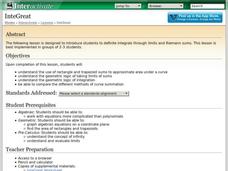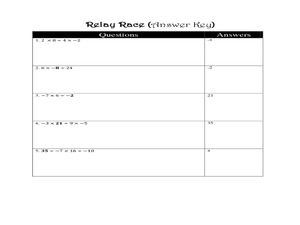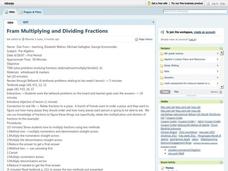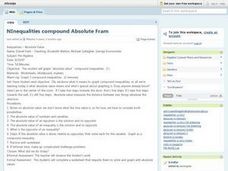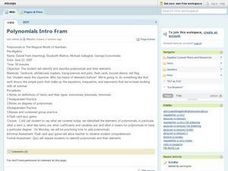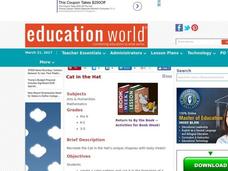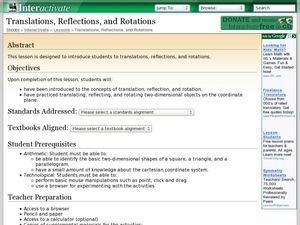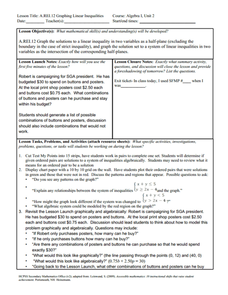Kenan Fellows
Isotopic Pennies
Many people confuse atomic mass and atomic numbers. The sixth of seven lessons in a unit requires scholars to find the weight of different groups of pennies. Then, they must solve how many of each type of penny exists in a closed system...
Ohio Department of Education
I Can Do This! Systems of Equations
Use tables, graphs, and substitution to solve systems of linear equations. An envelope of sample problems is passed around the classroom, and each learner has the opportunity to solve the system in the envelope. This is a great way to...
Ohio Department of Education
The Solution is Complex
Consider complex numbers, roots, and quadratic equations. Use the discriminate as a way to determine the nature of a quadratic's roots. Then discuss the similarities and differences between quadratics with two, one, or no real roots....
Shodor Education Foundation
InteGreat
Hands-on investigation of Riemann sums becomes possible without intensive arithmetic gymnastics with this interactive lesson plan. Learners manipulate online graphing tools to develop and test theories about right, left, and midpoint...
EduGAINs
Introduction to Solving Linear Systems
Word problems offer class members an opportunity to learn the concept of solving linear systems using graphs. Individuals choose a problem based upon preferences, break into groups to discuss solution methods and whether there is...
Curated OER
Multiplying and Dividing Integers/Relay Race
Give your class a list of multiplication and division sentences that contain both positive and negative integers. Have them analyze them to see if they can discover the pattern with the signs. From these patterns, help them develop the...
Curated OER
Multiplying Fractions
Middle schoolers investigate the concept of multiplying fractions and use the inverse for doing division. They practice working the problems with scaffolding provided by examples with the teacher. The link is made to real life with the...
Curated OER
Inequalities - Absolute Value
Students graph the absolute value of compound inequalities. Through a demonstration, students discover the meaning of absolute value. They take notes, rewrite opposites, and solve for each variable. Students complete a worksheet and...
Curated OER
Fractions Continued
Learners investigate the concept of using fractions to solve problems involving rational numbers. They order real numbers on the number line with the classification of fractions. Also students solve problems using the four operations...
Curated OER
Polynomials in The Magical World of Numbers
Students identify and describe polynomials and their elements, discuss simple parts that make up equations, inequalities, and exponents, take notes on definitions of terms and their types, including monomials, binomials, and trinomials,...
Curated OER
Cat in the Hat
Explore the book The Cat in the Hat by Dr. Seuss with your class. They will design a pattern for the cat's hat. They will create color pattern designs with candy and frosting. In the end, they will describe their pattern.
National Security Agency
Sampling for a Rock Concert
Over the course of three class periods, middle schoolers design an experiment to provide learner input to administration about which rock band to invite to play at school. They practice several random sampling exercises, all well...
Curated OER
Translations, Reflections and Rotations
Fifth graders use the Internet to learn about translations, reflections and rotations. Students access the Transmographer program on the Internet, where they practice what they have learned. Students also complete a worksheet.
Curated OER
Significant What?
High schoolers define accuracy and precision, and differentiate between the two terms, apply the concepts of accuracy and precision to a given situation and correctly apply the concept of significant figures to measurement and...
Curated OER
Density Derby
Students explore the relationship between mass, volume and density. They use model boats to discover how changing mass and volume affect density. This is a very engaging lesson which provides great demonstrations and hands-on activities.
Curated OER
Sir Cumference and the Dragon Pi
Geometry adventurers study circumference of a circle as they listen to Sir Circumference and the Dragon Pi, by Cindy Neuschwander. In groups, they use string to measure the diameter and circumference of circular objects and then consider...
Curated OER
Basic Math - Plan a Cruise
Young scholars measure distances and report them in fractions. They convert fractions to decimals and multiply decimals.
Curated OER
Composting
Eighth graders collect data from Bottle Biology compost columns and record using Excel spreadsheet.
Curated OER
Rules of Exponents
Students solve problems involving exponents. Through a teacher led discussion, students explore the rules of exponents and create cards with "x's" on them. Given a division problem, students lay out "x's" to represent the numerator and...
Curated OER
Squares and Square Roots II
Students evaluate squares and square roots. Through practice, they discover the inverse relationship between squares and square roots. Students take notes, solve square root and square root problems, and classify numbers as rational or...
Curated OER
Graphing Linear Inequalities
Eighth graders extend skills for representing and solving linear equations to linear inequalities. Lesson activities build understanding and skill by plotting ordered pairs of numbers that either satisfy or do not satisfy a given...
Curated OER
I Can Do This! Systems of Equations
Students solve systems of 2-by-2 linear equations using tables,
graphs and substitution. In small groups, classmates work together to discover strategies for solving equations. They use a calculator to graphically represent their answers.
Curated OER
Super Sort
Students sort objects based on one characteristic. They define the term "attribute" and give examples of attributes of objects. Students explain their reasoning for sorting objects into groups.
Curated OER
Describing Patterns
Fourth graders investigate repeating and growing patterns. Models, graphs and words are used to describe, extend and represent patterns. Students use evidence from models and graphs to support the identification of patterns.





